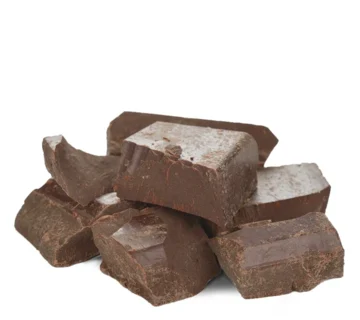Cocoa butter is a key ingredient in chocolate, providing the smooth texture and rich flavor. While it’s challenging to find a perfect substitute with identical properties, some alternatives can be used. Here are a few options:
Contact us to get this product at the best price and payment terms
- Coconut Oil:
- Pros: Coconut oil has a similar solidifying property at room temperature. It can provide a smooth texture and add a subtle coconut flavor.
- Cons: The flavor of coconut oil may alter the taste of your chocolate, and it has a lower melting point than cocoa butter.
- Shea Butter:
- Pros: Shea butter has a similar consistency to cocoa butter and is solid at room temperature.
- Cons: It has a distinct flavor that might affect the taste of your chocolate. Look for refined, odorless shea butter if you choose this option.
- Palm Oil:
- Pros: Palm oil is solid at room temperature and can mimic the texture of cocoa butter.
- Cons: There are environmental concerns associated with palm oil production, such as deforestation. If you choose palm oil, opt for sustainably sourced varieties.
- Mango Seed Butter:
- Pros: Mango seed butter has a similar texture to cocoa butter and a mild flavor.
- Cons: It might be less readily available than other substitutes, and the flavor may still differ from cocoa butter.
When substituting, it’s essential to consider the flavor and melting point of the alternative. Keep in mind that the exact proportions and the process of incorporating the substitute can vary based on the specific recipe. It’s a good idea to experiment in small batches to find the balance that works best for your taste preferences.
Cocoa butter substitutes (CBS) are fats used in the chocolate industry as alternatives to cocoa butter. Cocoa butter is the natural fat extracted from cocoa beans and is a key ingredient in traditional chocolate. However, in certain situations, such as cost considerations or specific formulation requirements, manufacturers may use cocoa butter substitutes. Here are some key points related to cocoa butter substitutes in chocolate:
- Composition:
- Cocoa butter substitutes are usually composed of vegetable fats or oils. Common sources include palm oil, shea butter, coconut oil, and other tropical oils. These fats are chosen for their ability to mimic the properties of cocoa butter.
- Melting Point:
- One of the critical characteristics of cocoa butter is its unique melting point, which is close to body temperature. Cocoa butter substitutes are formulated to have similar melting points to ensure that the chocolate has the desired texture and mouthfeel.
- Texture and Snap:
- Cocoa butter contributes to the snap, smoothness, and texture of chocolate. Cocoa butter substitutes aim to replicate these characteristics, ensuring that the chocolate maintains its quality and sensory attributes.
- Cost-Effectiveness:
- Cocoa butter substitutes can be more cost-effective than cocoa butter, which is a relatively expensive ingredient. This makes them attractive to chocolate manufacturers looking to manage production costs.
- Stability:
- The stability of cocoa butter substitutes is crucial to prevent issues such as blooming (white discoloration on the chocolate surface) and to ensure a longer shelf life for the chocolate products.
- Regulatory Compliance:
- Cocoa butter substitutes must comply with regulatory standards, including labeling requirements. It’s essential for manufacturers to ensure that the use of substitutes aligns with local and international regulations.
- Blending with Cocoa Butter:
- In some cases, chocolate manufacturers use a blend of cocoa butter and cocoa butter substitutes to achieve a balance between cost, texture, and flavor. This allows for a more customized approach to chocolate formulation.
- Temperature Tolerance:
- Cocoa butter substitutes may exhibit different temperature tolerance compared to cocoa butter. This can affect the chocolate’s resistance to melting or blooming under various storage conditions.
- Flavor Profile:
- Cocoa butter substitutes may have distinct flavor profiles compared to cocoa butter. Manufacturers need to consider the impact on the overall taste of the chocolate and adjust formulations accordingly.
- Consumer Perception:
- Maintaining the overall sensory experience of chocolate is crucial for consumer acceptance. Chocolate makers carefully select and blend cocoa butter substitutes to ensure that the final product meets consumer expectations.
It’s important to note that while cocoa butter substitutes offer certain advantages, they are not always a one-to-one replacement for cocoa butter. The choice between cocoa butter and substitutes depends on factors such as the desired product characteristics, cost considerations, and regulatory compliance.
cocoa butter substitute Supplier in Türkiye?















No comment